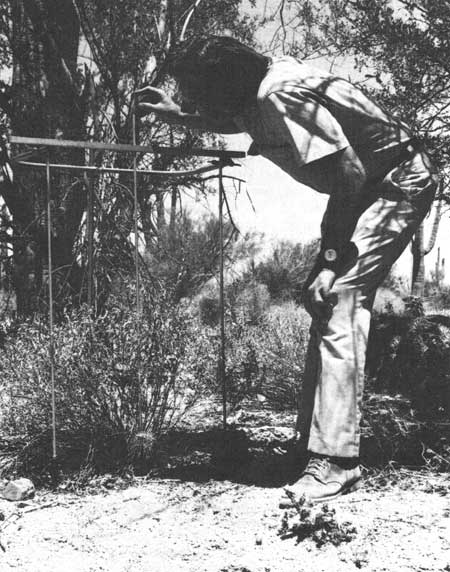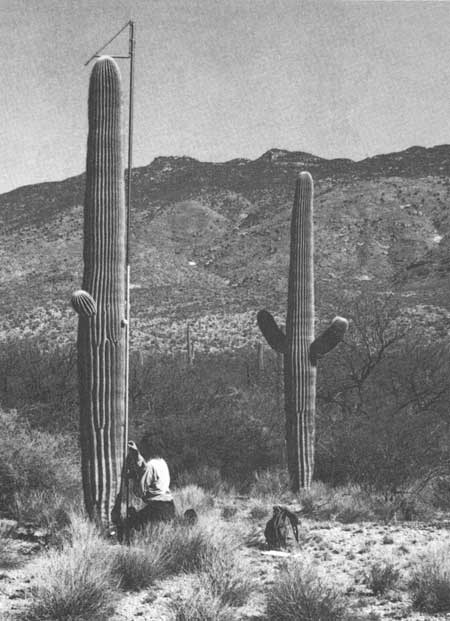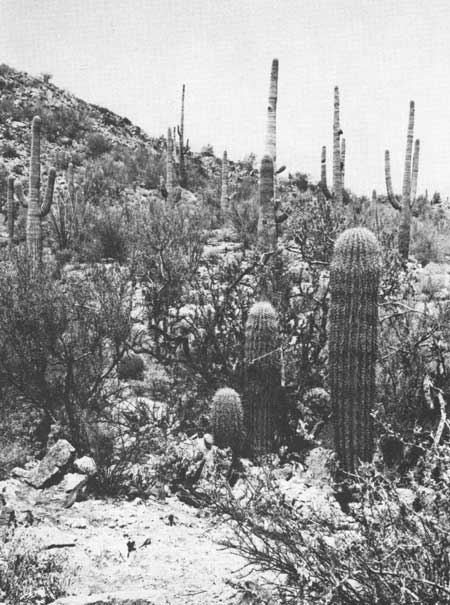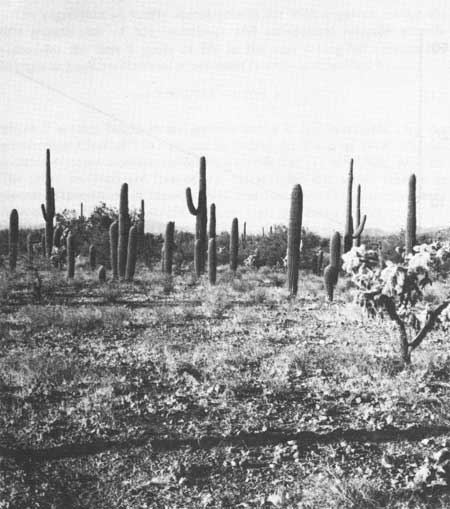|
SAGUARO
Ecology of the Saguaro: II NPS Scientific Monograph No. 8 |

|
CHAPTER 5:
GROWTH
It is difficult to find the very young Sahuaros. They are among the bushes under the palo verde and iron wood trees, and all that is to be seen of them is a gray tuft of spines. It is often ten or fifteen years before the seedling becomes large enough to be noticed, and twenty or thirty years before it begins to raise its head above the shrubbery which has sheltered its infancy. There is no direct way of telling the age of large cacti, as can be done by counting the growth rings of a leafy tree. The rate of growth of the Sahuaro is known, however, beginning at almost nothing and increasing to about four inches per year in large plants. The age of the largest ones can thus be estimated at from 125 to 175 years.—Forrest Shreve, "The cactus and its home." 1931a:120.
Our primary concern in this report is with young saguaros so small and inconspicuous during the first years of life that they live and die virtually unnoticed in their desert microhabitats. While there have been several studies on saguaro growth, they have all quite naturally centered on relatively large, easy to find, and easy to measure individuals. While further contributing to such information, for a decade we have been studying the seedlings and juveniles in their natural habitats, and the data provided here on growth were designed to fill in the gap in the growth curve for the first critical years of the saguaro's life. In addition to analyzing the effects of environment and time on saguaro growth and growth-rate, the data reported here also permit correct age determination for young saguaros at Saguaro National Monument.
Environmental factors that influence the germination and establishment of young saguaros discussed in earlier chapters also play important roles in saguaro growth. Short of becoming limiting—i.e., short of acting as final limiting factors in the species distribution—temperature, precipitation, and soil characteristics are among the important direct and indirect environmental modifiers of growth within the species range. Accordingly, as discussed under Geographic Variation in Growth, growth rates differ in different saguaro populations in different parts of its distribution.
The Start of
Growth
In the presence of continuously available moisture following germination, seedling development and growth are rapid and continuous. Within 24 hr after rupture of the seed coat, the slender, pale yellow-green seedling emerges upright. The base swells, cotyledons expand and spread to a horizontal position, and the saguaro seedling develops a light-green color—or in strong light, a pale red coloration—within one day following emergence. Stem development, with distinct areoles and spines, is evident within one week after the start of germination.
By the end of the first summer growth period, the green or reddish green seedling has 8, 12, or 16 areoles bearing well-developed spines. The total stem height is approximately 5.5 mm (0.22 inch), the diameter about 4.5 mm (0.18 inch), and the "taproot" is 1-2 cm (0.4-0.8 inch) in length. First-year stem height is ordinarily 1-2 mm (0.04-0.08 inch) greater in seedlings in flatland soils not associated with rock out cropping.
The principal growth occurs during June, July, August, and September, the period of warm summer rains, and ceases shortly after the end of those rains. Water uptake—replacement of moisture lost during the arid fall months—but no growth accompanies early winter rainfall and lower temperatures during late November, December, and January.
In years when late winter rains provide adequate soil moisture and warm temperatures prevail, a secondary and minor period of apical growth occurs as early as February and March.
In the presence of adequate moisture, some apical stem growth of seedlings (and larger saguaros as well) occurs during the arid fore-summer period. On seedlings this is evidenced by the growth of new, greenish-colored apical spines and on older juvenile plants, by the lengthening and red coloration of apical spines. However, because there is water stress and stem shrinkage during this driest portion of the year, an actual decrease in stem height and diameter of saguaros of all sizes can and usually does occur.
April, May, and June are the pre-summer drought months of increasingly severe moisture stress, with increasingly warmer temperatures and scanty if any rainfall; May and June are especially hot. During that period, seedlings commonly shrink to half their original volume, and exposed small and weak individuals die.
The second year of life, the post-seedling juvenile stage, begins abruptly with the first significant summer rain (0.20 inch; 5.1 mm or more) ordinarily in early July in southern Arizona and in late June in southern Sonora. Observable water uptake can occur within 20 hr after the wetting of the soil. With adequate moisture, full turgor is quickly attained and new apical growth is evident within 8 days.
Growth and Growth Rates of
Young Saguaros at Saguaro National Monument, Arizona
There have been no quantitative data available for natural saguaro growth during the seedling stage—the first year of life—and directly following early juvenile years. During these first critical years, saguaros are nearly invisible on the surface of the desert. Discovery requires work on hands and knees on the desert floor. As most one-year old saguaros are barely 5-6 mm (ca 0.25 inch) tall, and a large part of the tiny globular "stem" is underground, about all that the observant searcher can see is a small, concealing tuft of tan-colored spines.
After intensive searching, tiny saguaro seedlings and juveniles were discovered in the winter of 1965 in natural habitats under paloverde, mesquite, and bursage nurse-plants at Saguaro National Monument (see Chap. 6). The fate of these and other seedlings and young juvenile saguaros is reported by Steenbergh and Lowe (1969).
Naturally growing young saguaros at Saguaro National Monument (east) were measured to obtain data on stem form and growth rate characteristics for that population. Heights and diameters of individual, naturally established seedlings and young juvenile saguaros of known age (6-66 months) were measured in the field, the plants then removed and remeasured in the laboratory with precision calipers.
Data on the natural growth of larger juvenile plants were determined by yearly field measurements on a representative sample of the young saguaros at Saguaro National Monument (east) using permanent benchmarks and a specially designed gauge for stem height (Fig. 37) and machinist's calipers for diameter. The height and diameter of each individual was measured at one-year intervals. The difference between these consecutive annual measurements provides a series of one-year growth increments. These data provide a basis for estimating height, growth rate, and age relationships for young saguaros in this environment (Table 28; Figs. 39-41).

|
| Fig. 37A. Height gauge used to measure apical growth of juvenile saguaros. Two aluminum legs that support the horizontal cross-bar rest on paired permanent benchmarks—steel rods set in concrete in the ground. The center measuring-rod rests on the stem tip of the young plant. The portion of the measuring-rod that projects above the horizontal crossbar is measured with a millimeter rule (measurement accuracy ±1 mm). Apical growth increment (week, month, year) is obtained by subtracting the previous measurement; center measuring-rod is placed in the same relative position on the stem tip for successive growth measurements. Using longer legs to support the cross-bar, the same method is used to measure young plants 1-2 m (3.6-6.6 ft) tall. Photographed 21 May 1972. |

|
| Fig. 37B. Height gauge used to measure apical growth of adult saguaros. Horizontal cross-bar rests on the tip of the plant. A steel measuring tape attached to the telescoping pole (vertically oriented with a spirit level) is used to measure the distance from the horizontal cross-bar to a permanent steel benchmark at the base of the saguaro. A meter-stick resting on the benchmark allows eye-level reading to the nearest whole millimeter. The apical growth increment is obtained by subracting the previous measurement. Photographed 10 March 1974. |

|
|
Fig. 38A. Year-to-year variation in
length of saguaro spines, visible in the photographs as distinctive band
encircling the plant stem, reflects climatically related variations in
summer growth. Shorter spines are associated with periods of depressed
growth that result from freeze-caused injury, unusually dry summers, or
other causes. Note the change in form from the club shape of juvenile saguaros in the foreground to the bottle ("wine bottle") form of larger saguaros in the background (see text). Photographed 15 April 1971. |

|
| Fig. 38B. Saguaros in a permanent plot established in 1941 at Alamo Canyon, Organ Pipe Cactus National Monument, Arizona. Height of each individual, originally measured in 1941, was re-measured in 1967 thereby obtaining a 26-year apical growth increment (see Table 34). Accurate measurement is facilitated by permanent steel-in-concrete benchmark at the base of each plant. Photographed 11 February 1972. |

|
| Fig. 39. Regression on semi-logarithmic coordinates of stem height on age of young saguaros (N = 30) for the first 5 years following germination in nonrocky habitats at Saguaro National Monument (east), near Tucson, Arizona. In this equation 6 months = 1 growth year, 18 months = 2 growth years, etc. See text. |
The stem growth of young saguaros increases exponentially ("geometrically") with age and size. Yearly apical growth of young saguaros at Saguaro National Monument (east) is graphed in Fig. 40. The regression of one-year growth increments on stem height for 62 naturally growing seedlings and juvenile saguaros (Fig. 40) is described by equation (2) below.
The regression of yearly apical growth for wild saguaros during the first growth-year of life (seedling) and subsequent juvenile growth-years—for the first 6 years of life in flat and rolling-hill (nonrocky) habitats at Saguaro National Monument (east)—is described by
log Y = 0.741 + 0.012 X (1)
where Y is stem height in millimeters and X is age in months,1 for the germinating Class of 1963 to and including the Class of 1968. The associated product-moment correlation coefficient (r) is +0.936, N = 30. The years involved are free of the catastrophic-kill winter freezes as recently experienced in January 1962 and January 1971 in southeastern Arizona (see Niering et al. 1963; Steenbergh and Lowe 1976).
1In this equation, 6 months = 1 growth-year, 18 months = 2 growth-years, etc.
For the seedling year (Class of 1968) of this 6-year series, the measured mean stem height of the seedlings is 6.0 mm ± 0.37 (4.8-7.6), N = 8. Using equation (1), the least squares calculated first-year stem height (Y) is 6.5 (6.486) mm (N = 30), i.e., based on the growth data for all of the 6 successive years of saguaro classes (1963-68) in the study.
Accordingly, this derived best estimate for saguaro stem height attained during the first year of life at this specific locality is 0.6486 cm (0.26 inch). As it is the only natural first-year growth data in existence for the saguaro (or any other species of cactus), it might be assumed that it is applicable to saguaros elsewhere. We caution that that assumption is valid only in a highly restricted sense, for saguaro growth can and does vary significantly and widely from population to population in different environments, as well as from individual to individual in the same immediate environment. Compare, for example, the data in Tables 28-38.
| <<< Previous | <<< Contents >>> | Next >>> |
chap5.htm
Last Updated: 21-Oct-2005